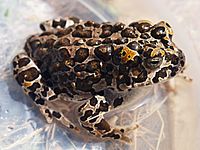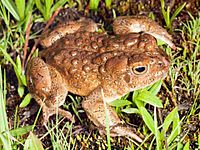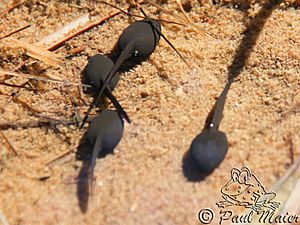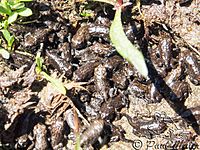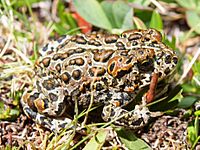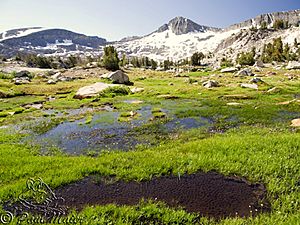Yosemite toad facts for kids
Quick facts for kids Yosemite toad |
|
|---|---|
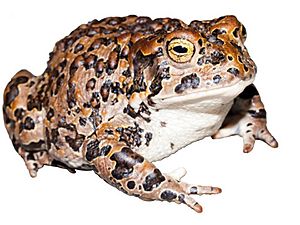 |
|
| Adult female in Kings Canyon | |
| Conservation status | |
| Scientific classification | |
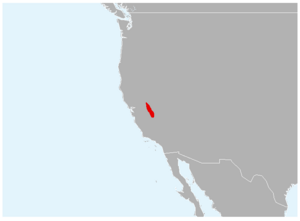 |
|
| Synonyms | |
|
Bufo canorus Camp, 1916 |
The Yosemite toad (Anaxyrus canorus) is a special kind of toad. It belongs to the family called Bufonidae, which includes true toads. This toad lives only in the Sierra Nevada mountains of California. You can find it from Alpine County all the way to Fresno County.
Yosemite toads live in high places, from about 1,950 to 3,445 meters (6,400 to 11,300 feet) above sea level. They are similar to the Western toad, but they have special ways of living in high mountains. A student named Charles Camp first described this toad in 1916.
Contents
What Does the Yosemite Toad Look Like?
Adult Toads
Yosemite toads are medium-sized toads. They are usually between 48 and 84 millimeters (about 2 to 3.3 inches) long. Female toads are generally bigger than males. Their eyes are dark brown with gold flecks.
These toads have large, oval-shaped glands behind their eyes called parotoid glands. These glands are close together. The skin on their back is smooth between the warts.
Yosemite toads are very unique because males and females look very different. This is called sexual dichromatism.
- Females have black spots with white or cream edges. Their background color can be tan, copper, or reddish.
- Males are more plain. They can be yellow-green, olive, or greenish-brown. Sometimes they have small black spots.
Unlike the Western toad, Yosemite toad males can make a sound. They have a vocal sac and make a high-pitched, flute-like trill to attract females. This call is why they were named "canorus," which means "tuneful."
Eggs and Tadpoles
Female toads lay 1,000 to 2,000 dark-colored eggs. The eggs are laid in one or two long strands. They are usually found tangled in plants in shallow pools. Each egg is about 2.1 mm wide.
Tadpoles are completely black and range from 10 to 37 mm long. Their eyes are on top of their heads. Yosemite toad tadpoles have a shorter, blunter snout than Western toad tadpoles. Their tail fins are mostly opaque.
Young Toads (Subadults)
When tadpoles first change into toads, they are called metamorphs. They are very small, usually 9 to 14 mm long. They are also very dark, like the tadpoles.
Young toads (juveniles) look like adult females. They have a brown or gray background with black spots. They also have a thin white or cream stripe down their back. This stripe fades as they grow. Males lose their black spots as they get older, while females' spots grow larger.
Yosemite toads become adults after several years. Males are ready to breed at 3 to 5 years old. Females are ready at 4 to 6 years old.
Yosemite Toad Life Cycle
Breeding Habits
Yosemite toads breed very quickly in late spring. They move to breeding pools when the snow is still melting. They are known for "tiptoeing" across snowdrifts to avoid the cold.
Breeding time depends on how much snow there is and how fast it melts. It can happen from April to July. Males arrive first at the ponds. They call to attract females or search for them.
When females arrive, males will try to grab them to mate. Females usually lay one batch of 1,000 to 2,000 eggs. The eggs hatch in 1 to 2 weeks, depending on the temperature. Females leave the breeding area after a few days. Males stay for 1 to 2 weeks.
Where Do They Live?
These toads mostly use wet meadows in the mountains for breeding. They like shallow ponds formed by melting snow. Eggs are laid in water less than 5 cm (2 inches) deep. This shallow water helps the eggs develop faster because it warms up quickly. However, it also makes them vulnerable to freezing at night.
Tadpoles gather in the warmest, shallowest parts of the ponds during the day. At night, they settle into the mud for warmth. This can make the pond look like a "golf ball" surface because of the small dips they leave.
It takes 4 to 6 weeks for tadpoles to change into metamorphs. This time depends on things like elevation, weather, and food. Tadpoles cannot survive the winter.
Adult and young toads move away from the breeding ponds. They find shelter in rodent burrows, willow bushes, logs, or rocks. These spots protect them from predators and bad weather.
How Far Do They Travel?
Yosemite toads often return to the same breeding pools and feeding areas each year. After breeding, adults usually stay within 90 meters (about 300 feet) of water.
Female toads travel farther than males. They have been known to move up to 1.26 kilometers (about 0.8 miles) from their breeding grounds in one season. However, they don't often move between different meadows.
Hibernation
Yosemite toads hibernate (sleep through the winter) in rodent burrows or thick willow bushes. They start hibernating in late summer or early fall, usually between September and October. The first freezing nights tell them it's time to find a winter home.
What Do They Eat?
Yosemite toads are ambush predators. They wait for prey, then lunge and catch it with their sticky tongue.
Adult toads eat many different insects and spiders. These include beetles, flies, caterpillars, ants, and millipedes. Young toads eat ants, spiders, and wasps. Metamorphs eat tiny things like spider mites and small flies.
Tadpoles mostly eat detritus (dead plant matter) and algae. They also sometimes eat other tadpoles or even pollen.
How They Survive in High Mountains
Yosemite toads have special ways to live in high elevations.
- They live a long time: males up to 12 years, females up to 15 years. This helps them survive years when breeding conditions are poor.
- They are active during the day (diurnal). Most toads are active at night. Being active during the day helps them absorb heat from the sun in the cold mountains.
- Their dark eggs and tadpoles also help them absorb heat.
- They choose shallow breeding sites. This helps their eggs and tadpoles develop quickly in the short mountain summer.
The big difference in color between male and female toads is still a mystery. One idea is that males and females live in different places. Males spend more time in shallow, muddy breeding ponds, where their color helps them blend in. Females quickly move to rocky, upland areas where their spotted pattern helps them hide.
Conservation Efforts
The number of Yosemite toads has gone down a lot. The biggest threats to them are drought (dry periods) and a disease called chytridiomycosis.
Because of these threats, the Yosemite toad is listed as "Endangered" by the IUCN. It is also listed as "Threatened" by the USFWS and a "California species of special concern" by the CDFW.
Toad Family Tree
| Phylogeny of Anaxyrus | |||||||||||||||||||||||||||||||||||||||||||||||||||||||||||||||||||||||||||||||||||||||||||||||||||
|
|||||||||||||||||||||||||||||||||||||||||||||||||||||||||||||||||||||||||||||||||||||||||||||||||||
| The placement of A. canorus is shown with (***). The relationships of the A. boreas group and the A. americanus group need further systematic study and taxonomic revision. The displayed cladogram is a consensus of Pauly 2008, Fontenot et al. 2011, and Peralta-García et al. 2016. A. compactilis and A. mexicanus are excluded because of exclusion from those studies, and A. williamsi because of insufficient evidence for splitting off from A. boreas. |
Scientists study how different toad species are related. The Yosemite toad (A. canorus) is part of a group that includes the Western toad and the Black toad. This chart shows how the Yosemite toad fits into the larger Anaxyrus family.
Images for kids
See also
 In Spanish: Sapo de Yosemite para niños
In Spanish: Sapo de Yosemite para niños



